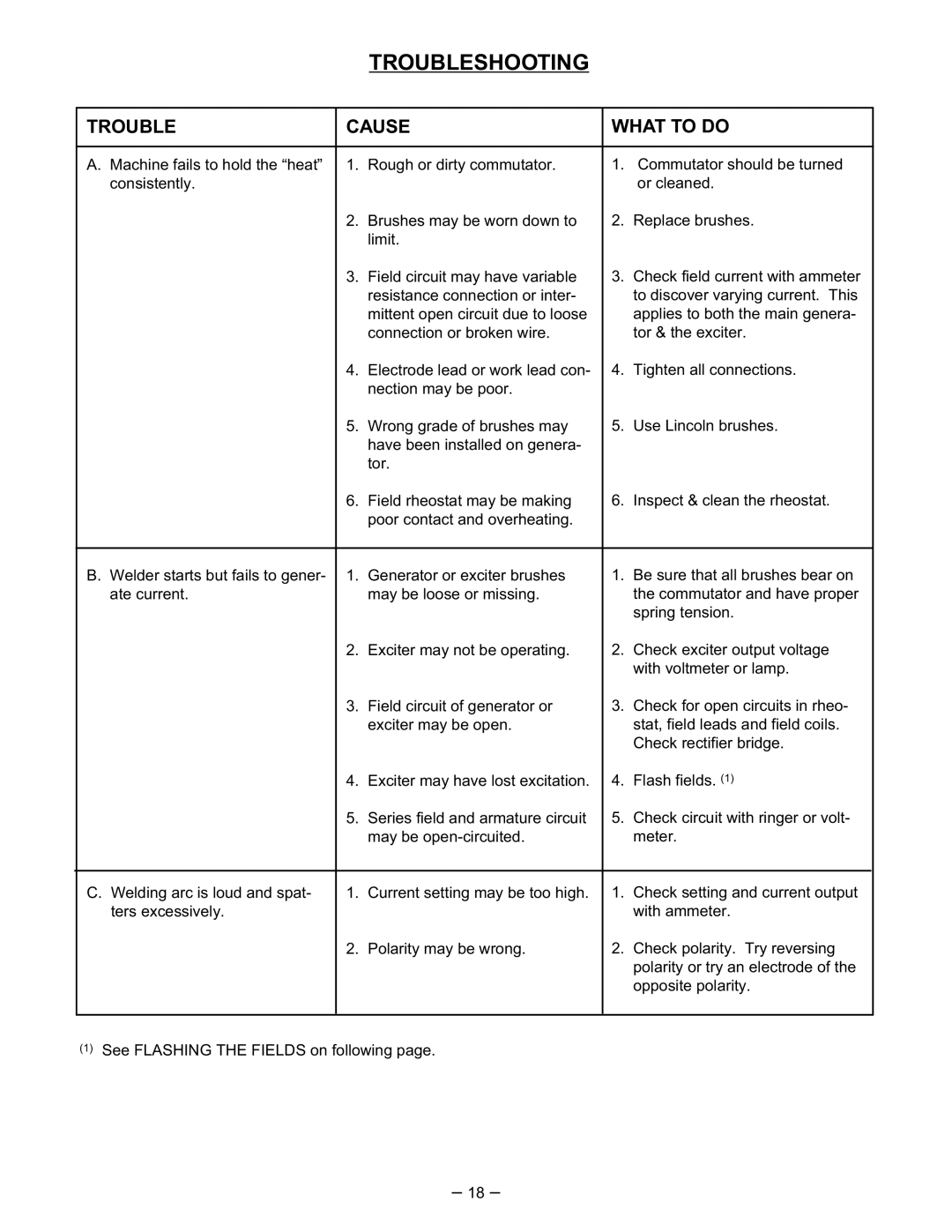TROUBLESHOOTING
|
|
|
|
|
|
|
|
|
|
|
| TROUBLE |
|
| CAUSE |
|
| WHAT TO DO |
| ||
|
|
|
|
|
|
|
|
|
|
|
| A. Machine fails to hold the “heat” |
|
| 1. | Rough or dirty commutator. |
|
| 1. | Commutator should be turned |
|
| consistently. |
|
|
|
|
|
|
| or cleaned. |
|
|
|
|
| 2. | Brushes may be worn down to |
|
| 2. | Replace brushes. |
|
|
|
|
|
| limit. |
|
|
|
|
|
|
|
|
| 3. | Field circuit may have variable |
|
| 3. | Check field current with ammeter |
|
|
|
|
|
| resistance connection or inter- |
|
|
| to discover varying current. This |
|
|
|
|
|
| mittent open circuit due to loose |
|
|
| applies to both the main genera- |
|
|
|
|
|
| connection or broken wire. |
|
|
| tor & the exciter. |
|
|
|
|
| 4. | Electrode lead or work lead con- |
|
| 4. | Tighten all connections. |
|
|
|
|
|
| nection may be poor. |
|
|
|
|
|
|
|
|
| 5. | Wrong grade of brushes may |
|
| 5. | Use Lincoln brushes. |
|
|
|
|
|
| have been installed on genera- |
|
|
|
|
|
|
|
|
|
| tor. |
|
|
|
|
|
|
|
|
| 6. | Field rheostat may be making |
|
| 6. | Inspect & clean the rheostat. |
|
|
|
|
|
| poor contact and overheating. |
|
|
|
|
|
|
|
|
|
|
|
|
|
|
|
|
| B. Welder starts but fails to gener- |
|
| 1. | Generator or exciter brushes |
|
| 1. | Be sure that all brushes bear on |
|
| ate current. |
|
|
| may be loose or missing. |
|
|
| the commutator and have proper |
|
|
|
|
|
|
|
|
|
| spring tension. |
|
|
|
|
| 2. | Exciter may not be operating. |
|
| 2. | Check exciter output voltage |
|
|
|
|
|
|
|
|
|
| with voltmeter or lamp. |
|
|
|
|
| 3. | Field circuit of generator or |
|
| 3. | Check for open circuits in rheo- |
|
|
|
|
|
| exciter may be open. |
|
|
| stat, field leads and field coils. |
|
|
|
|
|
|
|
|
|
| Check rectifier bridge. |
|
|
|
|
| 4. | Exciter may have lost excitation. |
|
| 4. | Flash fields. (1) |
|
|
|
|
| 5. | Series field and armature circuit |
|
| 5. | Check circuit with ringer or volt- |
|
|
|
|
|
| may be |
|
|
| meter. |
|
|
|
|
|
|
|
|
|
|
|
|
| C. Welding arc is loud and spat- |
|
| 1. | Current setting may be too high. |
|
| 1. | Check setting and current output |
|
| ters excessively. |
|
|
|
|
|
|
| with ammeter. |
|
|
|
|
| 2. | Polarity may be wrong. |
|
| 2. | Check polarity. Try reversing |
|
|
|
|
|
|
|
|
|
| polarity or try an electrode of the |
|
|
|
|
|
|
|
|
|
| opposite polarity. |
|
|
|
|
|
|
|
|
|
|
|
|
|
|
|
|
|
|
|
|
|
|
|
(1)See FLASHING THE FIELDS on following page.
– 18 –
